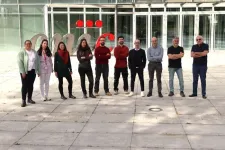(Press-News.org) When today’s older adults were growing up, urgent care centers and clinics inside retail stores didn’t exist. But most of them have now embraced these non-traditional sites for getting medical care, a new national poll finds.
In the past two years, 60% of people age 50 to 80 have visited an urgent care clinic, or a clinic based in a retail store, workplace or vehicle, according to new findings from the University of Michigan National Poll on Healthy Aging.
Urgent care clinics were the most common alternative source of care, with 47% of adults age 50-80 visiting one at least once, and 23% going more than once, in the past two years.
Many of those who went to any alternative site said they did so to avoid going to the emergency room (44%) or to get a vaccine, a test or an exam (35%). They went for a variety of health reasons, including getting immediate attention for symptoms and injuries, getting vaccinated, and receiving tests or treatments for COVID-19 infections.
And 75% of those who have gone to such a site recently say they’re likely to go again in the next two years.
But even as they sought care at these sites, most older adults who also have a primary care provider preferred the quality of care and sense of connection at their regular clinic. Among those who say they’re not likely to go to an alternative site for care in the future, 74% said it’s because they prefer to go to their regular provider.
The poll is based at the U-M Institute for Healthcare Policy and Innovation and supported by AARP and Michigan Medicine, U-M’s academic medical center. Two members of AARP’s Public Policy Institute worked with the poll team on the poll questions and report.
“The rapid rise in availability of these kinds of clinics, which typically offer walk-in convenience, expanded hours, and self-scheduling of appointments in locations close to home, work or shopping, has transformed the American health care landscape in less than two decades,” said poll director Jeffrey Kullgren, M.D., M.P.H., M.S. “With the nationwide shortage of primary care providers, it’s important to understand how this age group, with generally higher medical needs, views and uses this type of care.”
Kullgren is a primary care physician at the VA Ann Arbor Healthcare System and associate professor of internal medicine at U-M.
“Access to timely and convenient care was critical for older adults during the pandemic, and our research shows alternative care options will continue to be in demand for the long-term,” said Susan Reinhard, senior vice president and director of AARP Public Policy Institute. “Policymakers and clinicians must ensure that patients receive high quality care at sites like urgent care clinics that is well-coordinated with their usual health care provider.”
Other key findings from the poll:
The percentage of older adults who had gone to a retail clinic was half that of the proportion who had gone to an urgent care center, at 28% vs 47%. Only 9% had gone to a clinic at their worksite, and 5% had gotten care from a traveling provider based in a bus or van.
Those in their 50s and early 60s were more likely than those age 65 to 80 to have sought care from one of these types of alternative care sites, at 64% vs. 55%.
Women were more likely than men to have gone to an alternative site for care in the last two years, at 63% vs. 57%.
Older adults who live in urban or suburban areas with populations over 50,000 were more likely than those in less-populated areas to have gone to an alternative site for care, at 62% vs 52%.
61% of those who said they have a primary care provider said they visited an urgent care clinic, retail clinic or other alternative site in the past two years. The majority (64%) had let that regular provider know they had gone to an alternative site.
Asked to compare the two, 43% of those who had gone to an alternative site for care said the alternative site was more convenient than their usual provider. But 52% said the quality of care was better at their usual provider’s clinic, and 67% said they felt more connection to their provider at their usual clinic.
Cost does not seem to be a main driver for seeking care at a non-traditional site, with only 9% of alternative site users citing it as a reason. And 19% of those who had gone to an alternate care site said their alternative site was better on cost. Also, 23% of those who said they weren’t likely to go to an alternative site for care in the next two years said that they were concerned about cost or lack of insurance coverage for such care.
43% of those who haven’t gotten care at an alternative care site in the past two years say they are likely to do so in the next two years.
The poll report is based on findings from a nationally representative survey conducted by NORC at the University of Chicago for IHPI and administered online and via phone in July and August 2023 among 2,657 adults aged 50 to 80. The sample was subsequently weighted to reflect the U.S. population. Read past National Poll on Healthy Aging reports and about the poll methodology.
END
Thinking outside the doctor’s office: Poll looks at older adults’ use of urgent care, retail clinics and more
Majority have gotten health care at an “alternative” site in the past two years, but survey of people ages 50 to 80 shows variations in use, motivations and attitudes
2024-04-10
ELSE PRESS RELEASES FROM THIS DATE:
New mechanism discovered for the life-threatening arrhythmias in Andersen-Tawil syndrome
2024-04-10
A team at the Centro Nacional de Investigaciones Cardiovasculares (CNIC) has made a breakthrough discovery in the understanding of cardiac arrhythmias by unraveling the complexities of Andersen-Tawil syndrome (ATS), an extremely rare inherited cardiac disorder. Led by Dr. José Jalife, head of the CNIC Cardiac Arrhythmia Group, the study demonstrates that a specific genetic mutation (C122Y) in the Kir2.1 potassium channel alters the function not only of Kir2.1 but also of the main cardiac sodium channel NaV1.5, thus establishing a direct link with the life-threatening arrhythmias associated with ATS1.
The study, published in the journal Circulation Research, reveals that ...
Study suggests racial discrimination during midlife associated with Alzheimer’s disease pathology later in life
2024-04-10
WINSTON-SALEM, N.C. – April 10, 2024 – Racial discrimination experienced during midlife is associated with Alzheimer’s disease pathology, according to a new study from researchers at Wake Forest University School of Medicine and the University of Georgia.
The findings appear online today in Alzheimer’s & Dementia: The Journal of the Alzheimer’s Association.
“We know that Black Americans are at an elevated risk of Alzheimer’s disease and other dementias compared to non-Hispanic ...
The future of xenotransplantation is nearly here
2024-04-10
Embargoed until 10:30 a.m. Wednesday, 10 April, 2024 Central European Summer Time (GMT +2)
10 April, 2024, Prague, Czech Republic—Speaking today at the Annual Meeting and Scientific Sessions of the International Society for Heart and Lung Transplantation (ISHLT) in Prague, Muhammad Mohiuddin, MBBS, said xenotransplantation, hailed as the future of organ transplantation, is poised to become a clinical reality within the next several years.
In January 2022, the University of Maryland School of Medicine (UMSOM) became the first institution in the world to implant a genetically modified pig heart ...
Treating gum disease after heart rhythm ablation reduced risk of AFib recurrence
2024-04-10
Research Highlights:
Treating gum disease within three months after a heart procedure to correct an irregular heart rhythm, known as atrial fibrillation (AFib), may lower the chances of it reoccurring.
Inflamed gums may predict AFib recurrence after heart ablation, a procedure to fix the irregular heartbeat.
AFib patients should be examined for gum disease and encouraged to seek dental treatment, researchers said.
Embargoed until 4 a.m. CT/5 a.m. ET Wednesday, April 10, 2024
DALLAS, April 10, 2024 — Treating gum disease in the 3-months after a procedure to correct an irregular heartbeat known as atrial fibrillation ...
AI makes retinal imaging 100 times faster, compared to manual method
2024-04-10
Researchers at the National Institutes of Health applied artificial intelligence (AI) to a technique that produces high-resolution images of cells in the eye. They report that with AI, imaging is 100 times faster and improves image contrast 3.5-fold. The advance, they say, will provide researchers with a better tool to evaluate age-related macular degeneration (AMD) and other retinal diseases.
“Artificial intelligence helps overcome a key limitation of imaging cells in the retina, which is time,” said Johnny Tam, Ph.D., who leads the Clinical and Translational Imaging Section at NIH's National Eye Institute.
Tam ...
Impact of aldehydes on DNA damage and aging
2024-04-10
A team of researchers at Nagoya University in Japan has discovered that aldehydes are metabolic byproducts associated with premature aging. Published in Nature Cell Biology, their findings reveal insights into premature aging diseases and potential strategies to combat aging in healthy individuals such as controlling exposure to aldehyde-inducing substances including alcohol, pollution, and smoke.
A person's health can be harmed by aldehydes. However, the group’s findings suggest these detrimental effects also include aging. The team who made this discovery included Yasuyoshi Oka, Yuka Nakazawa, Mayuko Shimada, and Tomoo Ogi of Nagoya University.
“DNA ...
New method of measuring qubits promises ease of scalability in a microscopic package
2024-04-10
Chasing ever-higher qubit counts in near-term quantum computers constantly demands new feats of engineering.
Among the troublesome hurdles of this scaling-up race is refining how qubits are measured. Devices called parametric amplifiers are traditionally used to do these measurements. But as the name suggests, the device amplifies weak signals picked up from the qubits to conduct the readout, which causes unwanted noise and can lead to decoherence of the qubits if not protected by additional large components. More importantly, the bulky size of the amplification chain becomes technically challenging to work around as qubit counts increase ...
Study shedding new light on Earth’s global carbon cycle could help assess liveability of other planets
2024-04-10
Research has uncovered important new insights into the evolution of oxygen, carbon, and other vital elements over the entire history of Earth – and it could help assess which other planets can develop life, ranging from plants to animals and humans.
The study, published today in Nature Geoscience and led by a researcher at the University of Bristol, reveals for the first time how the build up of carbon-rich rocks has accelerated oxygen production and its release into the atmosphere. Until now the exact nature of how the atmosphere became oxygen-rich has long eluded scientists and generated conflicting explanations.
As carbon dioxide is steadily ...
Connecting lab-grown brain cells provides insight into how our own brains work
2024-04-10
Tokyo, Japan – The idea of growing a functioning human brain-like tissues in a dish has always sounded pretty far-fetched, even to researchers in the field. Towards the future goal, a Japanese and French research team has developed a technique for connecting lab-grown brain-mimicking tissue in a way that resembles circuits in our brain.
It is challenging to study exact mechanisms of the brain development and functions. Animal studies are limited by differences between species in brain structure and function, and brain cells grown in the lab tend to lack the characteristic ...
Breakthrough for next-generation digital displays
2024-04-10
Researchers at Linköping University, Sweden, have developed a digital display screen where the LEDs themselves react to touch, light, fingerprints and the user’s pulse, among other things. Their results, published in Nature Electronics, could be the start of a whole new generation of displays for phones, computers and tablets.
“We’ve now shown that our design principle works. Our results show that there is great potential for a new generation of digital displays where new advanced ...
LAST 30 PRESS RELEASES:
Orthopedics can play critical role in identifying intimate partner violence
Worms as particle sweepers
Second spider-parasitic mite described in Brazil
January 2026 issues of APA journals feature new research on autism, pediatric anxiety, psychedelic therapy, suicide prevention and more
Private equity acquired more than 500 autism centers over the past decade, new study shows
New cervical cancer screening guidelines from the US Department of Health and Human Services
Estimated burden of COVID-19 illnesses, medical visits, hospitalizations, and deaths in the US from October 2022 to September 2024
Smartphone use during school hours by US youth
Food insecurity and adverse social conditions tied to increased risk of long COVID in children
Earliest, hottest galaxy cluster gas on record could change our cosmological models
Greenland’s Prudhoe Dome ice cap was completely gone only 7,000 years ago, first GreenDrill study finds
Scientific validity of blue zones longevity research confirmed
Injectable breast ‘implant’ offers alternative to traditional surgeries
Neuroscientists devise formulas to measure multilingualism
New prostate cancer trial seeks to reduce toxicity without sacrificing efficacy
Geometry shapes life
A CRISPR screen reveals many previously unrecognized genes required for brain development and a new neurodevelopmental disorder
Hot flush treatment has anti-breast cancer activity, study finds
Securing AI systems against growing cybersecurity threats
Longest observation of an active solar region
Why nail-biting, procrastination and other self-sabotaging behaviors are rooted in survival instincts
Regional variations in mechanical properties of porcine leptomeninges
Artificial empathy in therapy and healthcare: advancements in interpersonal interaction technologies
Why some brains switch gears more efficiently than others
UVA’s Jundong Li wins ICDM’S 2025 Tao Li Award for data mining, machine learning
UVA’s low-power, high-performance computer power player Mircea Stan earns National Academy of Inventors fellowship
Not playing by the rules: USU researcher explores filamentous algae dynamics in rivers
Do our body clocks influence our risk of dementia?
Anthropologists offer new evidence of bipedalism in long-debated fossil discovery
Safer receipt paper from wood
[Press-News.org] Thinking outside the doctor’s office: Poll looks at older adults’ use of urgent care, retail clinics and moreMajority have gotten health care at an “alternative” site in the past two years, but survey of people ages 50 to 80 shows variations in use, motivations and attitudes






